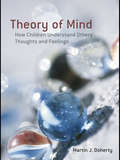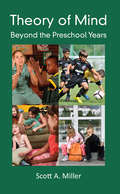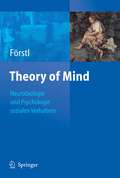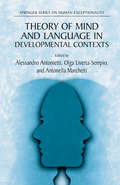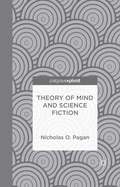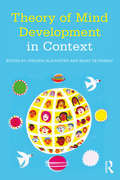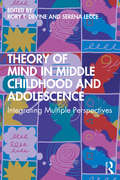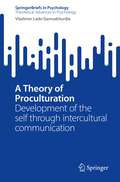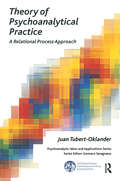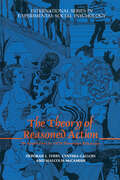- Table View
- List View
Theory of Mind: How Children Understand Others' Thoughts and Feelings (International Texts in Developmental Psychology)
by Martin DohertyMost of us are continually aware that others have thoughts and feelings – but are children? When? This book is a concise and readable review of the extensive research into children’s understanding of what other people think and feel, a central topic in developmental psychology known as "Theory of Mind". The understanding of belief is central to this text, which explains in simple terms what representational theory of mind is all about, and shows how researchers have demonstrated this understanding in 4-year-olds. The book considers what leads to this understanding, including the role of pretend play, understanding of attention and eye direction, and other precursors to representational understanding of mind. The general relevance of theory of mind is demonstrated through coverage of the development of other mental state concepts, and the relationship between understanding mental representation and other representational media. The author also carefully summarizes current research on the relationship between theory of mind and concurrent developments in executive functioning, and the understanding of language. The book closes by considering autism. A major achievement of theory of mind research is the light it has helped throw on this puzzling developmental disorder. Providing a comprehensive overview of 25 years of research into theory of mind, the book will be of great interest to both students and researchers in psychology, philosophy and the cognitive sciences.
Theory of Mind: Neurobiologie und Psychologie sozialen Verhaltens
by Hans FörstlTheory of Mind ist die Grundlage allen sozialen und „sittlichen“ Verhaltens. Rücksicht, Respekt und Mitgefühl kann nur entwickeln, wer Interesse am anderen hat, ein Gefühl für dessen Bedürfnisse und ein differenziertes Verständnis seiner Perspektiven. Störungen der Theory of Mind führen zu erheblichen Defiziten in der sozialen Interaktion; im vorliegenden Buch werden viele Beispiele dafür genannt.Für die 2. Auflage wurden die Kapitel aktualisiert und bearbeitet. Neu in dieser Ausgabe:- Mentalizing aus soziologischer Sicht- Neuronale Grundlagen- Rehabilitation
Theory of Mind: Beyond the Preschool Years
by Scott A. MillerThis is the first book to provide a comprehensive review of the burgeoning literature on theory of mind (TOM) after the preschool years and the first to integrate this literature with other approaches to the study of social understanding. By highlighting the relationship between early and later developments, the book provides readers with a greater understanding of what we know and what we still need to know about higher-order TOM. Although the focus is on development in typical populations, development in individuals with autism and in older adults is also explored to give readers a deeper understanding of possible problems in development. Examining the later developments of TOM gives readers a greater understanding of: Developments that occur after the age of 5. Individual differences in rate of development and atypical development and the effects of those differences. The differences in rate of mastery which become more marked, and therefore more informative, with increased age. What it means to have a “good theory of mind.” The differences between first- and second- order theory of mind development in preschoolers, older children, adolescents, and adults. The range of beliefs available to children at various ages, providing a fuller picture of what is meant by “understanding of belief.” After the introduction, the literature on first-order developments during the preschool period is summarized to serve as a backdrop for understanding more advanced developments. Chapter 3 is devoted to the second-order false belief task. Chapters 4 and 5 introduce a variety of other measures for understanding higher-level forms of TOM thereby providing readers with greater insight into other cognitive and social developmental outcomes. Chapter 6 discusses the relation between children’s TOM abilities and other aspects of their development. Chapters 7 and 8 place the work in a historical context. First, the research on the development of social and mental worlds that predated the emergence of TOM is examined. Chapter 8 then provides a comparative treatment of the two literatures and how they complement one another. Ideal as a supplement in graduate or advanced undergraduate courses in theory of mind, cognitive development, or social development taught in psychology and education. Veteran researchers will also appreciate this book‘s unique synthesis of this critical research.
Theory of Mind: Beyond the Preschool Years
by Scott A. MillerThis is the first book to provide a comprehensive review of the burgeoning literature on theory of mind (TOM) after the preschool years and the first to integrate this literature with other approaches to the study of social understanding. By highlighting the relationship between early and later developments, the book provides readers with a greater understanding of what we know and what we still need to know about higher-order TOM. Although the focus is on development in typical populations, development in individuals with autism and in older adults is also explored to give readers a deeper understanding of possible problems in development. Examining the later developments of TOM gives readers a greater understanding of: Developments that occur after the age of 5. Individual differences in rate of development and atypical development and the effects of those differences. The differences in rate of mastery which become more marked, and therefore more informative, with increased age. What it means to have a “good theory of mind.” The differences between first- and second- order theory of mind development in preschoolers, older children, adolescents, and adults. The range of beliefs available to children at various ages, providing a fuller picture of what is meant by “understanding of belief.” After the introduction, the literature on first-order developments during the preschool period is summarized to serve as a backdrop for understanding more advanced developments. Chapter 3 is devoted to the second-order false belief task. Chapters 4 and 5 introduce a variety of other measures for understanding higher-level forms of TOM thereby providing readers with greater insight into other cognitive and social developmental outcomes. Chapter 6 discusses the relation between children’s TOM abilities and other aspects of their development. Chapters 7 and 8 place the work in a historical context. First, the research on the development of social and mental worlds that predated the emergence of TOM is examined. Chapter 8 then provides a comparative treatment of the two literatures and how they complement one another. Ideal as a supplement in graduate or advanced undergraduate courses in theory of mind, cognitive development, or social development taught in psychology and education. Veteran researchers will also appreciate this book‘s unique synthesis of this critical research.
Theory of Mind: Neurobiologie und Psychologie sozialen Verhaltens
Zorzi von Castelfranco (»Giorgione« oder der große Giorgio) hinterließ ein rätselhaf es Bild, das nur einen Teil seiner Spannung aus dem Gewitter im Hintergrund bezieht. Da wir uns mit Psychologie und Hirnfunktion in sozialen Beziehungen beschäf igen, haben wir diese me- orologische Marginalie auf dem Umschlag abgeschnitten. Der Betrachter interessiert sich ohnehin vorrangig für Mutter und Kind, hell im rechten Vordergrund der bukolischen La- schaf . Das Kind interessiert sich dagegen für nahe liegende Schlüsselreize und nicht für e- fernte Betrachter aus einer späteren Epoche, wohl aber die Mutter, deren aufmerksamer Blick auf uns gerichtet ist, während sie ihrem Säugling eher nebenbei die Brust gibt. Dass ein Sö- ner mit Lanze am linken Bildrand mit gefälligem Interesse, aber ohne erkennbare Beziehung zur Mutter – ähnlich wie wir – auf sie schaut, irritiert zusehends. Wie Röntgenaufnahmen des Bildes zeigen, stand vorher an gleicher Stelle eine Nymphe im Wasser. Fand Giorgione es möglicherweise reizvoller, uns – in einem kühnen Vorgrif auf die Symbolik eines Sigmund Freud – quasi auf der Leinwand zu spiegeln und unsere Intentionen zu entdecken, während die mythologische Bedeutung und die psychologische Situation innerhalb des Bilderrahmens hermetisch verschlossen bleiben? Aber derartige hermeneutische Aufgaben gehören zum Kerngeschäf unseres Gehirns, und wir sind gewohnt, zu brauchbaren Arbeitshypothesen zu gelangen. T eory of Mind (ToM) ist der Versuch, andere und ihre Absichten zu verstehen und dadurch unser eigenes Verhalten vernünf ig anzupassen.
Theory of Mind and Language in Developmental Contexts (The Springer Series on Human Exceptionality)
by Alessandro Antonietti Antonella Marchetti Olga Liverta SempioProvides new empirical study data that explores the influence of linguistic variables within developmental contexts on theory of mind development and functioning Establishes context for usage, including personal, social, and business interactions Offers a comprehensive overview on the most current studies that address the relationship between language and theory of mind
Theory of Mind and Science Fiction
by N. PaganTheory of Mind and Science Fiction shows how theory of mind provides an exciting 'new' way to think about science fiction and, conversely, how science fiction sheds light not only on theory of mind but also empathy, morality, and the nature of our humanity.
Theory of Mind and the Triad of Perspectives on Autism and Asperger Syndrome: A View from the Bridge
by Olga BogdashinaInspired by the often uncomfortable interplay between autistic individuals, parents and professionals in understanding autistic spectrum conditions, Olga Bogdashina uses the concept of Theory of Mind (ToM) to consider these groups' different (and often conflicting) perspectives.
Theory of Mind Development in Context
by Virginia Slaughter Marc De RosnayTheory of Mind Development in Context is the first book of its kind to explore how children’s environments shape their theory of mind and, in turn, their ability to interact effectively with others. Based on world-leading research, and inspired by the ground-breaking work of Candida Peterson, the original collected chapters demonstrate that children’s understanding of other people is shaped by their everyday environment. Specifically, the chapters illustrate how theory of mind development varies with broad cultural context, socioeconomic status, institutional versus home rearing, family size, parental communication style, and aspects of schooling. The volume also features research showing that, by virtue of their condition, children who are deaf or who have an autism spectrum disorder function in environments that differ from those of typical children and this in turn influences their theory of mind. Although much important research has emphasized the role of nature in theory of mind development, this book highlights that children’s understanding of other people is nurtured through their everyday experiences and interactions. This perspective is essential for students, researchers, and practitioners to gain a complete understanding of how this fundamental skill develops in humans. The book is invaluable for academic researchers and advanced students in developmental psychology, education, social psychology, cognitive psychology, and the social sciences, as well as practicing psychologists, counselors, and psychiatrists, particularly those who deal with disorders involving social and/or communicative deficits.
Theory of Mind Development in Context
by Virginia Slaughter Marc De RosnayTheory of Mind Development in Context is the first book of its kind to explore how children’s environments shape their theory of mind and, in turn, their ability to interact effectively with others. Based on world-leading research, and inspired by the ground-breaking work of Candida Peterson, the original collected chapters demonstrate that children’s understanding of other people is shaped by their everyday environment. Specifically, the chapters illustrate how theory of mind development varies with broad cultural context, socioeconomic status, institutional versus home rearing, family size, parental communication style, and aspects of schooling. The volume also features research showing that, by virtue of their condition, children who are deaf or who have an autism spectrum disorder function in environments that differ from those of typical children and this in turn influences their theory of mind. Although much important research has emphasized the role of nature in theory of mind development, this book highlights that children’s understanding of other people is nurtured through their everyday experiences and interactions. This perspective is essential for students, researchers, and practitioners to gain a complete understanding of how this fundamental skill develops in humans. The book is invaluable for academic researchers and advanced students in developmental psychology, education, social psychology, cognitive psychology, and the social sciences, as well as practicing psychologists, counselors, and psychiatrists, particularly those who deal with disorders involving social and/or communicative deficits.
Theory of Mind in Middle Childhood and Adolescence: Integrating Multiple Perspectives
by Rory T. Devine Serena LecceThis landmark text integrates diverse perspectives on how humans understand others’ minds (or ‘theory of mind’) beyond early childhood into middle childhood and adolescence. It explores how the neural, cognitive, and social changes of middle childhood and adolescence shape the ongoing development of theory of mind, and how theory of mind helps children navigate their lives. Drawing on cutting-edge research from leading international experts, this book provides a survey and analysis of the current state and future direction of the field. It is organized around three themes relating to the key issues in contemporary research. The first part focuses on the biological and cognitive bases of theory of mind in middle childhood and adolescence. The second part goes on to explore the social predictors and consequences, considering how theory of mind is shaped by social experiences and, in turn, impacts children’s social lives in middle childhood and adolescence. Finally, the third part focuses on theory of mind in the context of neurodiversity, disability, and youth mental health in middle childhood and adolescence. Offering in-depth understanding for all students and scholars of developmental and cognitive psychology, neuroscience, clinical psychology and psychiatry, and education, this valuable text also identifies an agenda for future scholarship on this exciting topic.
Theory of Mind in Middle Childhood and Adolescence: Integrating Multiple Perspectives
by Rory T. Devine and Serena LecceThis landmark text integrates diverse perspectives on how humans understand others’ minds (or ‘theory of mind’) beyond early childhood into middle childhood and adolescence. It explores how the neural, cognitive, and social changes of middle childhood and adolescence shape the ongoing development of theory of mind, and how theory of mind helps children navigate their lives. Drawing on cutting-edge research from leading international experts, this book provides a survey and analysis of the current state and future direction of the field. It is organized around three themes relating to the key issues in contemporary research. The first part focuses on the biological and cognitive bases of theory of mind in middle childhood and adolescence. The second part goes on to explore the social predictors and consequences, considering how theory of mind is shaped by social experiences and, in turn, impacts children’s social lives in middle childhood and adolescence. Finally, the third part focuses on theory of mind in the context of neurodiversity, disability, and youth mental health in middle childhood and adolescence. Offering in-depth understanding for all students and scholars of developmental and cognitive psychology, neuroscience, clinical psychology and psychiatry, and education, this valuable text also identifies an agenda for future scholarship on this exciting topic.
The theory of planned behaviour (Large Print)
by Rnib BookshareThis is a flow chart diagram and consists of five boxes and eight arrows. There is a locator dot shown, which will be at the top left of the page when the image is the right way up. It shows the factors influencing planned behaviour in labelled boxes linked by arrows, and reads generally from left to right. Some arrows go in only one direction, whereas others are multi-directional, and some arrows link boxes horizontally, whereas others link boxes vertically.
The theory of planned behaviour (UEB Contracted)
by Rnib BookshareThis is a flow chart diagram and consists of five boxes and eight arrows. There is a locator dot shown, which will be at the top left of the page when the image is the right way up. It shows the factors influencing planned behaviour in labelled boxes linked by arrows, and reads generally from left to right. Some arrows go in only one direction, whereas others are multi-directional, and some arrows link boxes horizontally, whereas others link boxes vertically.
The theory of planned behaviour (UEB Uncontracted)
by Rnib BookshareThis is a flow chart diagram and consists of five boxes and eight arrows. There is a locator dot shown, which will be at the top left of the page when the image is the right way up. It shows the factors influencing planned behaviour in labelled boxes linked by arrows, and reads generally from left to right. Some arrows go in only one direction, whereas others are multi-directional, and some arrows link boxes horizontally, whereas others link boxes vertically.
A Theory of Proculturation: Development of the self through intercultural communication (SpringerBriefs in Psychology)
by Vladimer Lado GamsakhurdiaIn each connection with new cultural contexts a new hybrid state of cultural adaptation is constructed enabling people to adjust to new conditions by creating innovative solutions for the self. This book aims to provide a brief presentation of innovative cultural psychological theory of proculturation reflecting and oriented on the understanding of semiotic and developmental dynamics of higher mental phenomena while engaging alien signs through intercultural communication. The exploration and theoretical understanding of developmental dynamics (such as self and identity construction) of people who live in immigration or multicultural, or even multi-ethnic societies, the research builds its new focus in contrasts with the acculturation theories currently present in social psychology. The theory of proculturation has been built in opposition to cross-cultural psychological theories as well as mainstream theories of acculturation research dominated by bidimensional theoretical models. Instead, this theory is constructed based on theoretical explorations which are rooted in cultural semiotics and developmental psychological paradigm on human psychology.
Theory of Psychoanalytical Practice: A Relational Process Approach (The International Psychoanalytical Association Psychoanalytic Ideas and Applications Series)
by Juan Tubert-OklanderThis book makes an original contribution to the study of the psychoanalytic process from a relational point of view, and at the same time serves as a textbook on the theory of technique. It provides a general exposition of the theory of psychoanalytic practice from a process perspective that emphasizes the analytic relationship, the dyadic nature of the psychoanalytic situation, and the impact of unconscious interaction between its two parties, and also includes the authors personal point of view and contributions on the subject.
Theory of Psychoanalytical Practice: A Relational Process Approach (The International Psychoanalytical Association Psychoanalytic Ideas and Applications Series)
by Juan Tubert-OklanderThis book makes an original contribution to the study of the psychoanalytic process from a relational point of view, and at the same time serves as a textbook on the theory of technique. It provides a general exposition of the theory of psychoanalytic practice from a process perspective that emphasizes the analytic relationship, the dyadic nature of the psychoanalytic situation, and the impact of unconscious interaction between its two parties, and also includes the authors personal point of view and contributions on the subject.
The Theory of Reasoned Action: Its application to AIDS-Preventive Behaviour (International Series in Social Psychology)
by Cynthia Gallois Malcolm McCamish Deborah J. TerryThe Theory of reasoned action explores the theory and emphirical reserach in to the factors which influence whether people engage in high-risk practices , with specific reference to AIDS education.
The Theory of Reasoned Action: Its application to AIDS-Preventive Behaviour (International Series in Social Psychology)
by Deborah J. Terry Cynthia Gallois Malcolm McCamishThe Theory of reasoned action explores the theory and emphirical reserach in to the factors which influence whether people engage in high-risk practices , with specific reference to AIDS education.
The theory of reasoned action (Large Print)
by Rnib BookshareThis is a flow chart diagram and consists of four boxes and four arrows. There is a locator dot shown, which will be at the top left of the page when the image is the right way up. It shows the factors influencing reasoned action. It has four labelled boxes linked by arrows, and reads generally from left to right. However, one arrow is multi-directional, and the arrows can link boxes vertically and horizontally.
The theory of reasoned action (UEB Contracted)
by Rnib BookshareThis is a flow chart diagram and consists of four boxes and four arrows. There is a locator dot shown, which will be at the top left of the page when the image is the right way up. It shows the factors influencing reasoned action. It has four labelled boxes linked by arrows, and reads generally from left to right. However, one arrow is multi-directional, and the arrows can link boxes vertically and horizontally.
The theory of reasoned action (UEB Uncontracted)
by Rnib BookshareThis is a flow chart diagram and consists of four boxes and four arrows. There is a locator dot shown, which will be at the top left of the page when the image is the right way up. It shows the factors influencing reasoned action. It has four labelled boxes linked by arrows, and reads generally from left to right. However, one arrow is multi-directional, and the arrows can link boxes vertically and horizontally.
A Theory of Subjective Wellbeing (Philosophy, Politics, and Economics)
by Mark FabianThe study of 'subjective wellbeing' has seen explosive growth in recent decades, opening important new discourses in personality and social psychology, happiness economics, and moral philosophy. Now it is moving into the policy domain. In this it has arguably overstepped its limits. The shallow theoretical base of subjective wellbeing research, the limitations of its measurement instruments, and its ethical naivety makes policymaking on the basis of its findings a risky venture. The present volume is an attempt to shore up these weaknesses and set subjective wellbeing scholarship on a course for several more decades of growth and maturity. It presents a theory of subjective wellbeing in two parts. The first is the subjective wellbeing production function-a model of wellbeing as outcome. The second is the coalescence of being: a model of the self-actualisation process by which wellbeing is achieved. This two-part model integrates not only ideas in SWB studies and analytical philosophy, but also ideas from clinical, moral, and developmental psychology, continental philosophy, and welfare economics. Importantly, this theory is ethically sensitive, bridging the gap between psychological and philosophical perspectives on wellbeing that illuminates the complexities facing the application of subjective wellbeing in public policy. The book also provides a thorough review of various ways complex theories of subjective wellbeing can be studied empirically, and the hard trade offs between long surveys that capture the richness of the concept and the short surveys that are feasible in the context of social surveys and policy analysis.
A Theory of Subjective Wellbeing (Philosophy, Politics, and Economics)
by Mark FabianThe study of 'subjective wellbeing' has seen explosive growth in recent decades, opening important new discourses in personality and social psychology, happiness economics, and moral philosophy. Now it is moving into the policy domain. In this it has arguably overstepped its limits. The shallow theoretical base of subjective wellbeing research, the limitations of its measurement instruments, and its ethical naivety makes policymaking on the basis of its findings a risky venture. The present volume is an attempt to shore up these weaknesses and set subjective wellbeing scholarship on a course for several more decades of growth and maturity. It presents a theory of subjective wellbeing in two parts. The first is the subjective wellbeing production function-a model of wellbeing as outcome. The second is the coalescence of being: a model of the self-actualisation process by which wellbeing is achieved. This two-part model integrates not only ideas in SWB studies and analytical philosophy, but also ideas from clinical, moral, and developmental psychology, continental philosophy, and welfare economics. Importantly, this theory is ethically sensitive, bridging the gap between psychological and philosophical perspectives on wellbeing that illuminates the complexities facing the application of subjective wellbeing in public policy. The book also provides a thorough review of various ways complex theories of subjective wellbeing can be studied empirically, and the hard trade offs between long surveys that capture the richness of the concept and the short surveys that are feasible in the context of social surveys and policy analysis.
